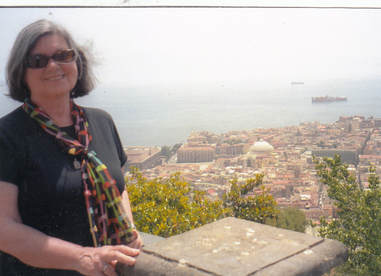 Sherrill & the Bay of Naples
Sherrill & the Bay of Naples The train to Naples when we left Rome after a couple of days was much faster than the local trains we endured in 1978 because of the Italian passion for strikes that start and stop without warning. This time, we were able to really explore the city, starting with the archaeology museum, including the adults-only room of frescoes from Pompeii. A self-guided walking tour of old Naples, up and down hills and through a kaleidoscope of neighborhoods took us from the castle on the bay to the Galleria shopping arcade that rivals Milan's venerable one, then on to a tour of the San Carlo Opera House, where we learned about its long history. Along the way, we stopped for lunch in a little trattoria that we discovered and would have returned to if we'd remembered how to find it.
"Nobody can say we're not flexible," I told Sherrill.
"Yes, dear," she replied. "Nobody can say that."
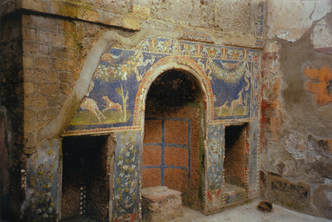 Herculaneum home: Mosaics & frescoes
Herculaneum home: Mosaics & frescoes Another day, another series of train rides: first to the remains of the buried city of Heculaneum, which turned out to be closed (of course) because of a "staff meeting"—that is, somebody explained, a temporary strike. So we took another train to Pompeii, which we discovered was closed for its morning strike. Eventually, we got into Pompeii and discovered that a great deal more of the ancient city had been uncovered and restored since 1978. We tried to see it all, despite the terrible heat and lack of shade. Although we drank water constantly and rested from time to time, Sherrill turned quite pink.
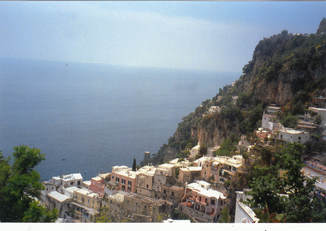 Positano on the way to Amalfi
Positano on the way to Amalfi * * *
"At least, I'm not driving!" Sherrill told me the next day, as she stared out the bus window at the blue sea and sky meeting on the horizon.
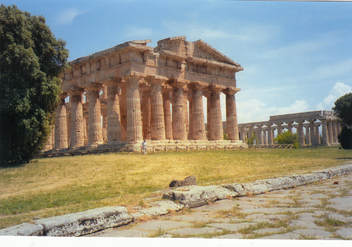 Paestum, Second Temple of Hera
Paestum, Second Temple of Hera 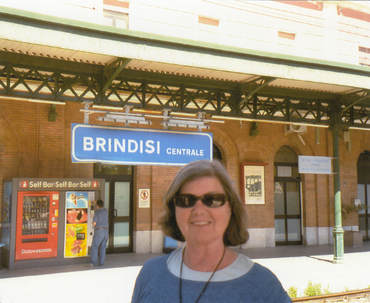 Sherrill en route south to Lecce
Sherrill en route south to Lecce "We all do this," she said, "because bleeding Australia is so far from everything else."
Her partner, she told us, was married to another woman, the three of them living together—still, there she was wandering alone for six months, making her plans as she went.
Salerno, that evening, was bouncing. We strolled out a pedestrian street filled with people of all ages doing the traditional passeggiata, but some also were campaigning, because the Saturday and Sunday coming up were election days. Several piazzas were taken over by the political parties. Finally, we reached what was left of the old town after the wartime bombing, where we ate a typical meal of the area: melanzana (eggplant) and frutta de mare (seafood). Simple fare, but well prepared.
* * *
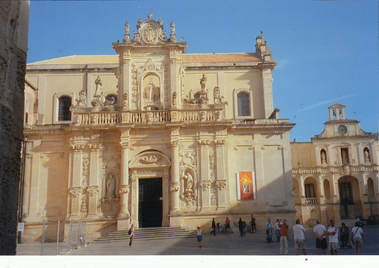 Piazza del Duomo, Lecce
Piazza del Duomo, Lecce The cab driver who picked us up at Lecce's station told us that the hotel we wanted didn't exist anymore and took us instead to a B and B also near the historic Baroque section of the city. The couple running it seemed awfully buddy-buddy with the driver, I thought, and it was hard for me to get a straight answer from them about the price for the room. I should have walked out then, but after our long train journey Sherrill and I just wanted to rest. The room was okay, but the next morning for breakfast we were given a note to take to a cafe around the corner, where we each got a hard roll and cup of coffee.
"That's all?" I asked the counter man.
"Si. E tutto."
From Lecce we took a train north from the pointed heel of the boot along the Adriatic coast to the busy port city of Bari. (The morning we left Lecce, the hotel proprietor and I argued about the amount due and two days later Sherrill realized that one of her blouses was missing—for whatever reason. However, we didn't let any of that spoil our memories of Lecce.) Bari's new city wasn't very interesting, but we enjoyed exploring the old part of town.
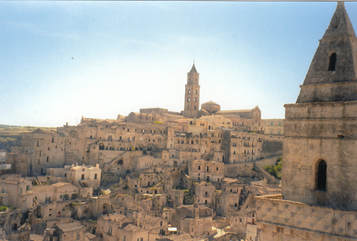 Cave houses, Matera, many with added facades
Cave houses, Matera, many with added facades An hour and a half by train through olive groves brought us back in time to one of the oldest continuously inhabited cities in the world, the hillside town of Matera. We hiked In the broiling sun along its steep twisting streets, exploring the homes dug into the hills and cliffs. The ancient town had been carved along a rocky ravine, facades and other rooms added much later. Even churches were cut into the cliff. Only in the 1950s did the Italian government force most of the population to move out. Recently, a number of movies had been filmed there, including Pasolini's The Gospel According to St. Matthew and Mel Gibson's The Passion of Christ. Maybe it didn't look exactly like Bethlehem, but it definitely looked ancient.
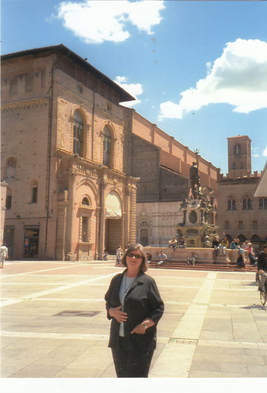 Sherrill, Bologna
Sherrill, Bologna 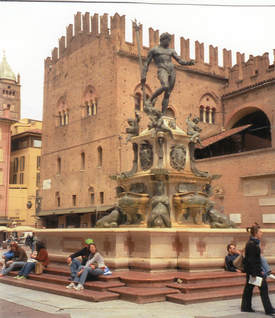 Neptune fountain by Bologna University
Neptune fountain by Bologna University Mostly, we enjoyed wandering around Bologna's old city. When we stopped to look at the 18th century theatre, we chanced onto a dress rehearsal of a dance show and were taken to watch from our own box. Some of the dancers were in 18th century costumes, others almost naked. A Don Juan figure in blue pantaloons danced barefooted—until he descended into Hell.
In one small church, we found a gorgeous Cimabue Madonna and child in remarkable condition. We wanted a postcard of it, but the place seemed deserted. Finally, we located a caretaker who took us through a series of back rooms where he presented us to an old man who took us to another room (that he had to unlock). The walls were covered with tall wooden cabinets that he opened and closed until he found the drawer with the postcards. He'd worked so hard that we bought several—then he didn't know how much to charge us.
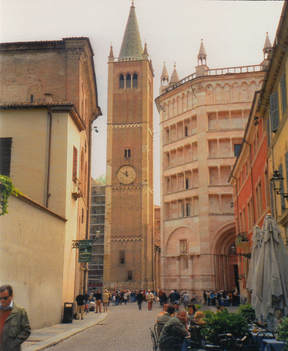 Parma: Campanile & Baptistry
Parma: Campanile & Baptistry 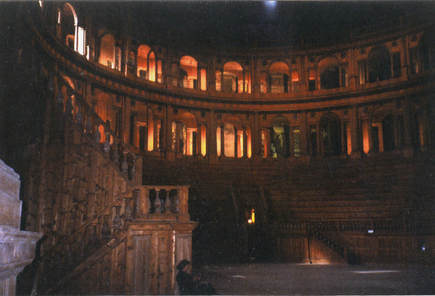 Farnese Palace theater, Parma
Farnese Palace theater, Parma From Parma, we trained to Milan, where eventually we got a plane to San Francisco. People often asked us what our favorite country was. Increasingly, we answered, "Italy, of course!"
To be continued....
Please pass the posts on to anybody else you think might enjoy them.
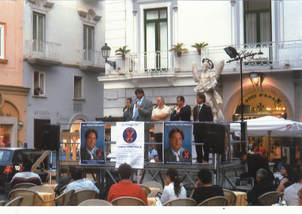
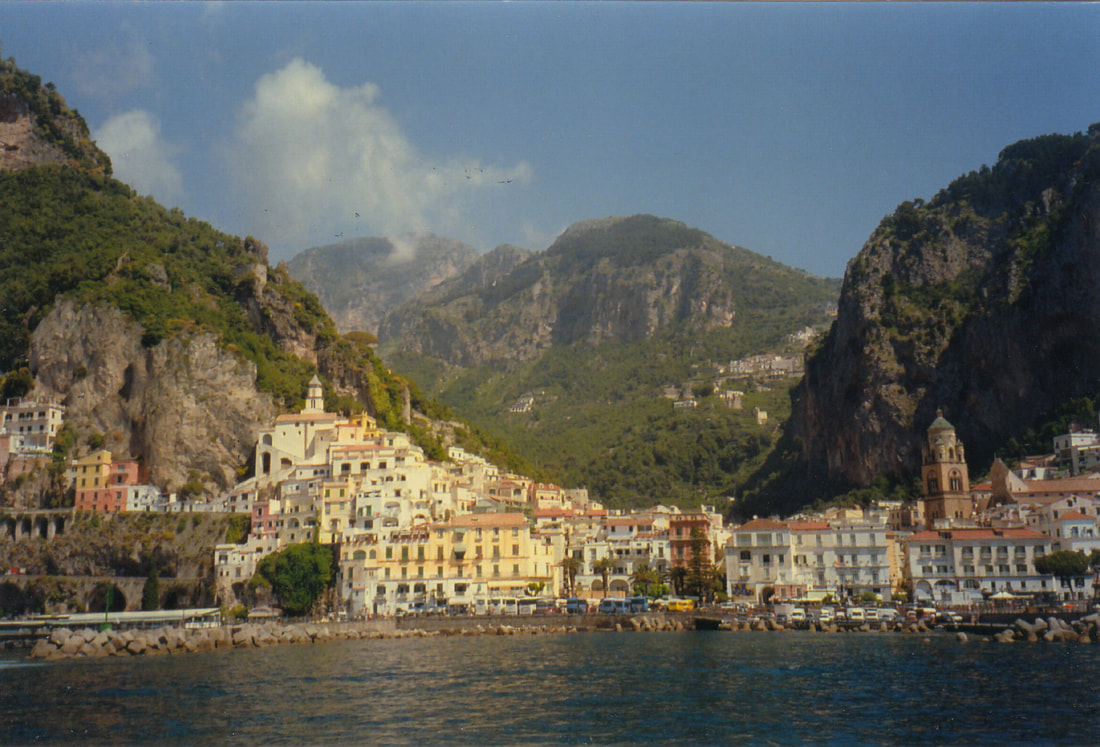
 RSS Feed
RSS Feed